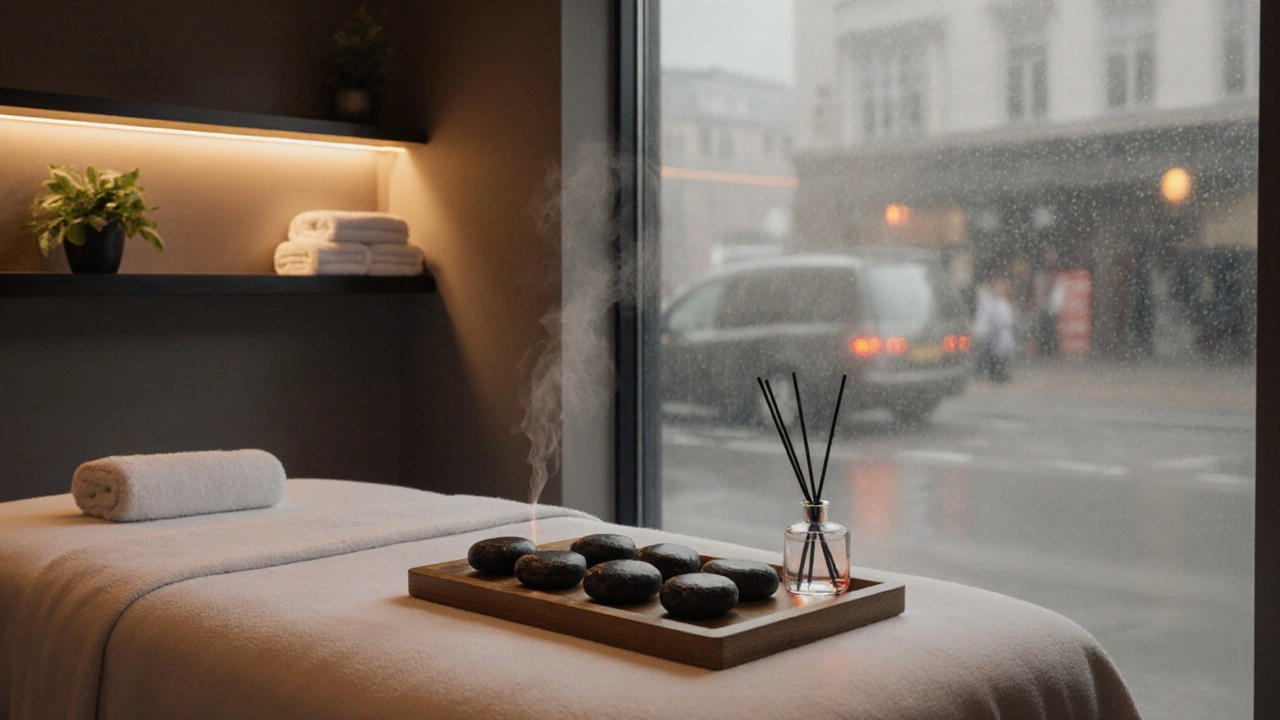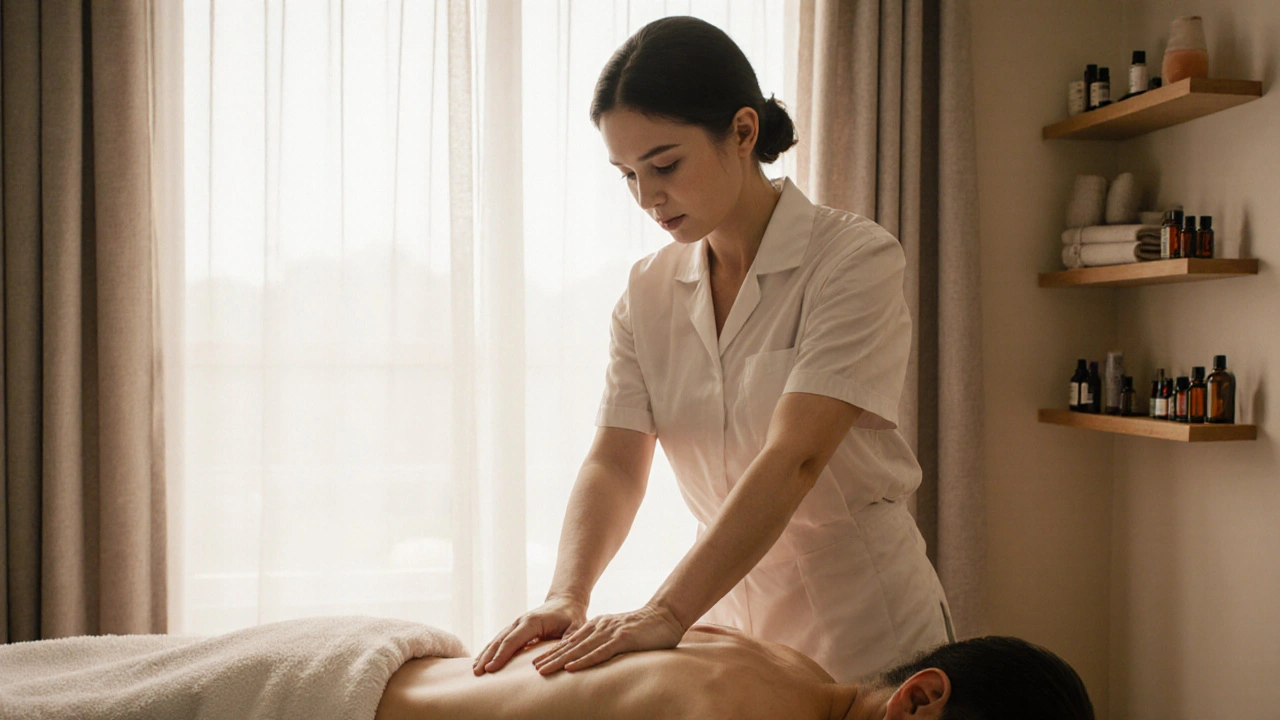Discover what a hot stone massage in London feels like, from stone placement and benefits to pricing, safety tips, and how to book your session.

- Created by: Archer Caldwell
- Completed on: 15 May 2025
- Categories: Body Massage
Most of us think of massage as a way to spoil ourselves—something you do maybe on vacation or as a rare treat. But here's the kicker: regular massages aren't just good for relaxation, they're legit smart for your overall health. Studies have shown they can help with chronic pain, reduce anxiety, improve sleep, and even lower blood pressure. Pretty wild, right?
If you're stuck in the daily grind, always hunched over your desk or chasing after kids (trust me, chasing Finley is an Olympic sport), you know how sore muscles can suck the fun out of life. That's where body massage comes in. It's not a quick fix but, over time, it can seriously change how you feel day to day. You invest in the things that matter—why not your own body?
The options aren't all the same, though. Swedish, deep tissue, sports—each style does something a little different. So if you're looking to ease tense shoulders, recover from a long run, or just chill out, there's a massage for you. And finding the right therapist is honestly half the battle. You want someone with the skills, not just strong hands.
- Why Massage Matters
- Types of Massage & What They Do
- Choosing a Great Massage Therapist
- What To Expect and How To Prep
Why Massage Matters
So, why bother fitting a massage into your packed week? The short answer: body massage pays off way beyond the hour you’re on the table. It’s not just about chilling out (though, yes, that’s a massive perk). The benefits run deeper—and science backs this up.
For starters, regular body massage helps kick chronic muscle pain to the curb. If you’re someone who struggles with back or neck tension from sitting at a laptop all day or just normal life stress, those knots aren’t just annoying—they can turn into bigger health headaches down the line. Massage relieves muscle tightness, improves flexibility, and reduces the risk of injury as you get older. Pretty practical, right?
We can’t ignore stress. The American Psychological Association says 77% of people in the U.S. regularly feel physical symptoms caused by stress. Here’s the cool part: body massage can drop your levels of the stress hormone cortisol by up to 30%. That means lower blood pressure and a chilled-out mood—not just while you’re on the table, but for days after.
| Benefit | What You Get |
|---|---|
| Pain Reduction | Eases muscle pain and tension |
| Better Sleep | Boosts serotonin and helps you sleep deeper |
| Less Anxiety | Lowers stress hormones and promotes calm |
| Improved Flexibility | Keeps your joints and muscles moving freely |
| Immune Support | Improves lymph flow (means a healthier immune system) |
Here’s another stat that grabs attention: a Harvard Medical School article pointed out that in people with chronic headaches, just one to two sessions of body massage a week for six weeks led to fewer headaches and migraines. That means less time missing out on stuff you actually want to do.
Is business booming for massage? Absolutely. Over 45 million Americans got at least one massage in 2024, and more doctors are recommending it as a part of routine health plans, not just “wellness” or luxury. Long story short: if you make time for your car’s oil change, your muscles deserve some tuning up too.
- Relieves everyday aches so you don’t have to pop painkillers
- Helps you recover faster if you work out (or just wrangle hyper kids)
- Builds up resilience against injuries and sickness
The main thing is, investing in body massage isn’t pampering—it’s basic maintenance for your body and mind. Your future self will thank you for it.
Types of Massage & What They Do
If you’re new to the world of body massage, all the different styles might make your head spin. Each massage type targets different needs—some are gentle, others dig deep. Picking the right one depends on what your body is asking for. Here’s a look at some of the most popular kinds, and what you can expect from each:
- Swedish Massage: The classic go-to. Gentle strokes, good if you’re stressed or just want to relax. It boosts circulation and helps loosen tight muscles without much pain. Most first-timers start here. Great for basic stress relief.
- Deep Tissue Massage: This one's for stubborn knots and serious muscle tension. The therapist uses slow, firm pressure to get deeper into those problem spots. Good for athletes, folks with chronic pain, or anyone who sits at a desk all day with tense shoulders.
- Sports Massage: Tailored for active people, this mix of techniques can help with injury recovery or muscle prep before a big event. It’s not just for pros—if you hit the gym or run, sports massage can help keep you moving.
- Hot Stone Massage: Uses heated stones along with standard massage techniques. The heat melts away tension and helps blood flow. It’s super soothing—ideal if you have stubborn tightness but don’t love deep pressure.
- Thai Massage: This one’s a little different. You stay clothed, and the therapist moves your body through stretches, almost like assisted yoga. Great for improving flexibility and leaving you surprisingly energized.
Still unsure? Here’s a quick table to compare some basics:
| Massage Type | Best For | Pressure Level | Session Length |
|---|---|---|---|
| Swedish | Stress, first-timers | Light to medium | 50-90 minutes |
| Deep Tissue | Chronic pain, tension | Firm | 60-90 minutes |
| Sports | Active lifestyle, injuries | Medium to firm | 30-60 minutes |
| Hot Stone | Muscle stiffness, relaxation | Light to medium | 60-90 minutes |
| Thai | Flexibility, energy | Varies | 60-90 minutes |
One quick tip—if you’re not sure what you need, tell your therapist about your aches or stress. Most are happy to mix techniques to get the best results for you. If you have a sore back from hauling groceries or you’re just wiped out, there’s a massage type to match.

Choosing a Great Massage Therapist
Picking the right person for your body massage can make or break your experience. A skilled therapist knows how to read your body, adjust pressure, and spot any problem areas. Don't settle—here's how you find someone worth your time and cash.
Start by checking credentials. Most states require massage therapists to be licensed, usually meaning they’ve finished 500+ hours of training and passed a state exam. If your therapist doesn’t display their license somewhere, ask. No shame in wanting proof—they should be cool about it.
Next up: experience. Therapists who’ve logged more hours tend to be better at zeroing in on what you need. Ask how long they've been practicing, and whether they specialize in the style you’re after. Got stubborn back pain? You want a therapist with plenty of deep tissue or sports massage experience, not just Swedish for relaxation.
Reputation matters, too. Check ratings on Google or Yelp, and don’t just focus on the stars—read the reviews. Look for feedback on professionalism, communication, comfort, and results. If you belong to a local parents’ group or community forum, crowdsource some real-life recommendations. People are surprisingly honest about what worked (and what didn’t).
Here’s a breakdown of what to look for in a great therapist versus a so-so one:
| What to Check | Great Therapist | Red Flags |
|---|---|---|
| License & Certifications | Active, visible license; certified in special techniques if needed | No proof, out-of-date certification |
| Experience | Several years, specialized skills | Sketchy about background, zero specialties |
| Client Reviews | Consistent, positive feedback | Negative or missing reviews |
| Communication | Clear, asks about your health & goals | Ignores or brushes off your concerns |
Before your session, don’t be afraid to call and ask how they handle things like allergies, injuries, or special requests. A legit pro will take your health seriously and never pressure you to book extra services. You can even book a shorter intro session to see if it’s the right fit before going for a full hour.
One last tip: trust your gut. If something feels off, or you’re not super comfortable with their vibe, don’t sweat it—move on and keep looking. A good therapist makes you feel heard and safe, not just relaxed. That’s how you know you’ve found someone truly invested in your well-being.
What To Expect and How To Prep
Walking into a massage session for the first time? It's normal to feel a mix of excitement and nervousness. Knowing what happens before, during, and after your session makes things a whole lot easier—and gets you ready to enjoy every minute. Let's break down what really goes on and how you can set yourself up for the best results.
First, you'll usually fill out a quick health form. Therapists ask about allergies, injuries, or problem areas—this isn’t nosy, it’s for your safety. Don't be shy or embarrassed. The more open you are, the better the therapist can help you.
You’ll be shown to a private room and given a few minutes to undress to your comfort level—underwear stays on or off, it's always your call. You’ll get under a sheet or towel, and most places leave only the area getting worked on exposed. Privacy is a big deal; therapists are trained for this.
During the session, your therapist might check in about pressure and comfort. Don’t tough it out if something feels weird; speak up! This is your hour. Some folks chat, others nap or just zone out to the music. Both are normal.
Here are some simple steps to make your body massage smooth and stress-free:
- Shower beforehand, especially if you’re coming from work or the gym.
- Avoid heavy meals right before, or you might feel bloated.
- Show up about 10 minutes early to settle in and fill out forms.
- Hydrate before and after—the body releases toxins and you’ll feel better if you’re not dehydrated.
- If you have questions or want something (like focus on your lower back), say so!
Wondering how long a session lasts or how often you should get a massage? Here’s a handy table with the basics people usually ask about:
| Session Type | Typical Length | Frequency Suggestion |
|---|---|---|
| Relaxation/Swedish | 60 minutes | Monthly or biweekly |
| Deep Tissue | 60-90 minutes | Every 3-4 weeks or as needed |
| Sports Massage | 30-60 minutes | Before/after events or weekly if training hard |
After your massage, take things easy for an hour or so. Drink water, skip super tough workouts, and give your body time to chill. If something feels off that night (headache, sore spot), let your therapist know next time—they might adjust their technique.
If you want the full benefit, treating this less like a one-time splurge and more like regular self-care pays off. Most people notice real changes—less tension, better sleep, even fewer headaches—after a few steady sessions. That’s how it becomes a real investment instead of just a treat.
Looking for the best massage near you but not sure where to start? This guide breaks down everything you need to know—from types of massages to what to expect during your first session. You'll get insider tips on how to book, what it should cost, and how to spot a safe, quality spot right in your neighborhood. Plus, find out what sets different massage styles apart and get answers to those questions you’ve probably Googled. No fluff, just straight-up advice you can use today.
A massage therapist doesn't just relieve muscle tension - they help reset your nervous system, reduce stress, and support long-term wellness. Discover how professional massage therapy fits into your health routine.



